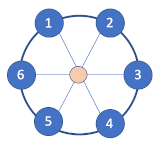The Daedalus Seven is a massive generation ship that I designed for Episode #34 of the weekly Hourlings Podcast Project, released on June 12, 2021. The topic was “World-Building: Generation Ship,” primarily because my fellow podcaster, Jeffrey C. Jacobs, wanted to have an episode on world-building for spaceships.
As the lead for the topic, I deliberately went larger than my fellow podcasters were expecting. I designed the generation ship, so-called because the journey to any nearby star via slower than light (STL) transportation will likely take multiple generations. Equally important, I defined the scenario that governed the ship’s long voyage. But I left much of the world-building unfinished, waiting for others to flesh out the details. For example, I didn’t detail the civilizations aboard the ship, or the likely flora and fauna of the various habitats.
In short, this is a world-building exercise for a spaceship large enough to warrant some serious world-building effort. Part 1 (this entry) will discuss the general setting, the generation ship itself. Part 2 details the situation in which the Daedalus Seven finds itself after an extraordinarily long voyage, including specific world-building exercises. Part 3 will leverage the world-building to develop feasible plotlines. It will also provide some additional background on megastructures and useful references, including SF works that have prominently featured generation ships.
Without further ado, let’s take a look at this generation ship.
The Daedalus Seven
The Daedalus Seven is a huge ship, pulled through space by a large solar sail. Trailing behind the sail, the remnant of an asteroid, now safely tethered in place, serves as both a shield for the habitable areas of the vessel and a resource for elements that need replenishment over time.
The asteroid is followed by seven spindles, with one central spindle surrounded by six other spindles arranged in a circle. The central spindle contains the core operational infrastructure for the ship, including a rotating crew habitat, ship operations, mining facilities, factories, storage, fuel tankage, and propulsion. The other six spindles support a large, rotating habitat, each with a different ecosystem.

The crew spindle is longer than the other spindles. The nozzles of the ship’s propulsion units extend back from the end of the crew spindle. A detailed view of the crew spindle is shown below:

The Habitats

Each habitat is a modified O’Neil Cylinder, i.e. – the cylinders rotate around their central axis allowing centrifugal force to simulate gravity. The living areas of each habitat are thus the inside surface of the cylinder. The crew habitat is the smallest, with only about 1% of the surface area of the other habitats.
Habitats are arranged in pairs, with each habitat paired with the habitat directly across from it in the circle. A single rotating cylinder tends to experience some
The dimensions of the habitats are shown below:

Each large habitat provides 308 square kilometers of surface area. However, the bases (the ends) of each cylinder contain a little bit over forty square kilometers each, leaving roughly 226 square kilometers of lateral surface area. That lateral area is suitable for farming, allowing the habitats to grow their own food. Each habitat devotes a significant percentage of its area to water features. Additionally, all of the habitats, including the smaller
The bases of the cylinders are interesting. Each base is much like a cliff face, with stronger gravity at the outer edges. Gravity declines as one
Each habitat was originally configured to provide 1 G of gravity. Additionally, to conserve
The classic O’Neill Cylinders provided three cylinder-length windows (and an elaborate mirror system) to direct sunlight into the habitat. Since that’s not viable on an interstellar journey, there is an internal spindle that runs down the zero-g center of each cylinder. The center 60% of each internal spindle is a critical component known as the Sun Tube, which provides light and heat (as needed) to the cylinder. It also defines the day and night cycles for each habitat.
Next Steps
Part 1 (this entry) of this world-building exercise has provided the details of the setting, the vast generation ship known as the Daedalus Seven.
Part 2 defines the scenario, in which a badly damaged spaceship has continued its voyage through interstellar space, having long since overshot its original destination. It also provides world-building opportunities for the surviving civilizations, the ecosystems for each habitat (and some other portions of the spaceship), and other key details affecting the ship’s probable fate.
Finally, Part 3 focuses on potential plot lines leveraging the world-building that has been completed for the Daedalus Seven. Useful references and literary recommendations are also provided.


Leave a Reply